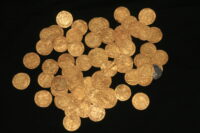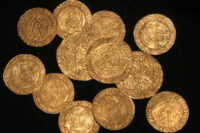 A little lockdown weeding has unearthed a Tudor-era hoard of 63 gold coins and one silver coin in a backyard in New Forest, Hampshire. The family was turning up soil to clear weeds when the gold coins sprang from the ground. The coins range in date from the late 15th century to the early 16th and were issued during the reigns of Edward IV (r. 1461-1470), Henry VII and Henry VIII.
A little lockdown weeding has unearthed a Tudor-era hoard of 63 gold coins and one silver coin in a backyard in New Forest, Hampshire. The family was turning up soil to clear weeds when the gold coins sprang from the ground. The coins range in date from the late 15th century to the early 16th and were issued during the reigns of Edward IV (r. 1461-1470), Henry VII and Henry VIII.
Most of the coins are of a type known as “angels” for the design on the obverse of the archangel Michael slaying a dragon (ie, satan) with a cross- shaped spear. First minted under Edward IV in 1465, angels were the standard gold coin in Britain for two centuries. The dates of the coins in the hoard suggest they were buried around 1540. The total value of the coins in 1540 was £24, which was much more than average annual wage in the Tudor era. On the auction market today, the coins would be worth around £220,000.
shaped spear. First minted under Edward IV in 1465, angels were the standard gold coin in Britain for two centuries. The dates of the coins in the hoard suggest they were buried around 1540. The total value of the coins in 1540 was £24, which was much more than average annual wage in the Tudor era. On the auction market today, the coins would be worth around £220,000.
John Naylor, from the Ashmolean Museum, said the hoard was likely to have been hidden either by a wealthy merchant or clergy fearful of Henry VIII during the Dissolution of the Monasteries, in which he took control of many of the religious community’s assets.
Mr Naylor said: “It is likely that there are two options of who may have buried a hoard like this. It could be a merchant’s hoard. There was a lot of wealth in that part of the world. The wool trade was still very
important. The New Forest is also very close to the coast and very close to some major ports so it is entirely possible it could be someone involved in maritime trade.
“On the other hand though, you also have this period in the late 1530s and 1540s where you have the Dissolution of the Monasteries. We do know that some monasteries and some churches did try to hide their wealth hoping that they would be able to keep it in the long term.”
Four of the gold coins are of particular note: they bear the initials of three of the wives of King Henry VIII. The first three of the six, to be precise — K for Catherine of Aragon, A for Anne Boleyn and I for Jane Seymour. The one with Jane’s initial is the earliest coin in the hoard dating to 1536 or 1537. Henry’s choice to give his wives cameos on his coins was unprecedented at the time and his motivation for it remains unknown. After Jane died giving birth to his obsessively-wanted heir, Henry stopped putting his temp spousal staff on the coinage.
This year has seen a rise in backyard finds reported to the Portable Antiquities Scheme as the pandemic has kept people at home. More than 47,000 finds have been reported this year in the UK, 6,251 made during the first lockdown when metal detecting was prohibited and people turned to their own properties for fun and profit. Last year the number of archaeological find recorded by the PAS was 81,602, a leap of 10,000 from 2018. Obviously people’s backyards don’t provide quite so rich a terrain for archaeological prospecting as, you know, the whole country.
It pays to weed.
Would not the Jane Seymour be the latest in the group not the earliest? She died that year giving birth. I would not think the initials of earlier wives would appear after their fall from royal favor.